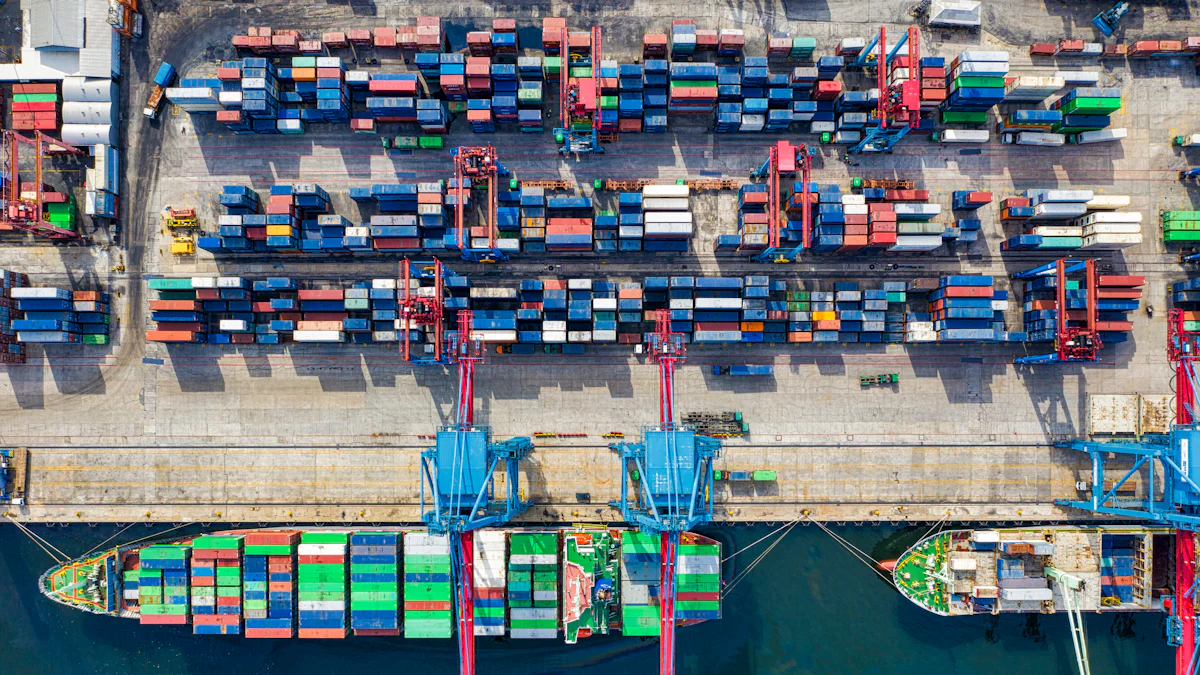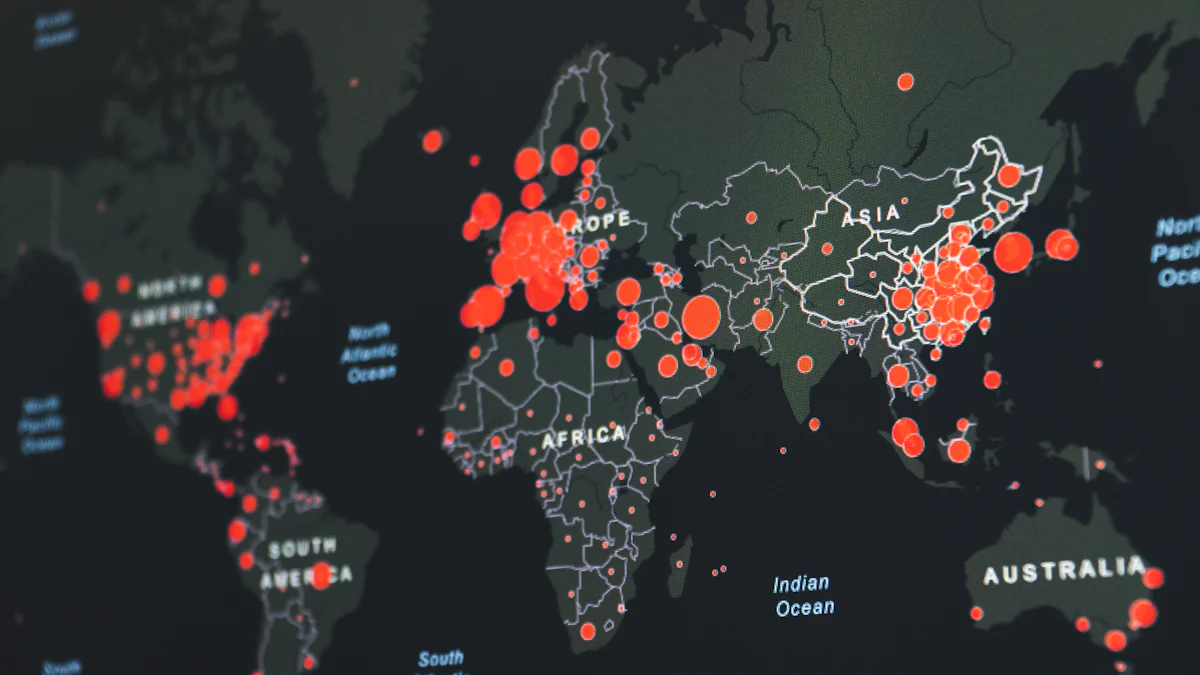Top 2024 Global Supply Chain Risks to Watch

In 2024, supply chain executives are actively enhancing their strategies to tackle supply chain risks head-on. With a significant 86% implementing crucial process and tech stack changes, the industry is gearing up for potential disruptions. A staggering 33% have completely overhauled their operations, emphasizing the critical need for adaptability. Moreover, diversifying supply bases (41%) and reskilling workforces (36%) showcase a proactive approach to mitigate emerging challenges. As organizations navigate through uncertainties, staying vigilant and agile is paramount in safeguarding against unforeseen risks.
Geopolitical Instability

Amidst the dynamic landscape of global trade, supply chain risks are magnified by geopolitical instability. The Black Sea conflict and disruptions in vital trade routes like the Panama Canal and Suez Canal have sent ripples through supply chains worldwide. These events have reshaped traditional trade patterns, impacting the flow of essential goods across borders.
The ongoing crisis in Ukraine has particularly reverberated across Eastern Europe, a key region for agricultural and metal production. This disruption has not only led to economic challenges but also highlighted vulnerabilities in supply chains reliant on these regions for crucial commodities.
Tensions between nations have escalated, leading to increased restrictions that can impede trade flows and trigger supply chain disruptions globally. Such restrictions pose challenges not only for direct trading partners but also for third-party countries caught in the crossfire of geopolitical conflicts.
Moreover, volatile freight costs stemming from shipping disturbances at strategic canals further compound supply chain risks. The unpredictability in freight expenses adds another layer of complexity for supply chain professionals navigating through turbulent waters.
As geopolitical unrest continues to shape the global economic landscape, organizations must remain vigilant and adaptable to mitigate the impact of these multifaceted risks on their supply chains.
Economic Uncertainty
In the realm of supply chain operations, supply chain risks are further exacerbated by economic uncertainties. Fluctuations in inflation rates and currency values can significantly impact the overall costs within the supply chain network. These fluctuations create a ripple effect, influencing pricing strategies and budget allocations across various sectors.
When inflation rates surge, the subsequent rise in supply chain costs poses a considerable challenge for organizations aiming to maintain profitability. The increased expenses associated with sourcing raw materials and transportation can strain operational budgets, necessitating swift adaptations to mitigate financial strains.
To counteract the adverse effects of currency fluctuations on procurement and distribution processes, companies often resort to hedging strategies. By strategically hedging against volatile exchange rates, businesses aim to stabilize their financial positions and safeguard against sudden currency devaluations or appreciations.
Recession Risks
Navigating through recession risks demands a keen understanding of demand forecasting dynamics. In times of economic downturns, accurately predicting consumer demands becomes paramount for optimizing inventory levels and production schedules. The ability to forecast demand trends effectively enables businesses to align their supply chains with market needs efficiently.
Amid recession risks, implementing robust cost management techniques is essential for sustaining business operations. Controlling expenditures while maintaining service quality requires meticulous planning and strategic decision-making. Cost optimization measures such as streamlining processes and renegotiating contracts can help mitigate financial vulnerabilities during challenging economic climates.
Technological Disruptions
Cybersecurity Threats
Software supply chain risks are heightened by the prevalence of cybersecurity threats. More than 75 percent of software supply chains have encountered cyberattacks in the past year, underscoring the critical need for robust security measures. These threats target vulnerabilities within supply chain systems, posing significant challenges to the integrity and confidentiality of sensitive data.
To combat cybersecurity risks effectively, organizations must prioritize proactive security protocols. Implementing stringent access controls, encryption mechanisms, and regular system audits are essential practices to safeguard against potential breaches. By fortifying their defenses and staying informed about evolving cyber threats, businesses can enhance the resilience of their supply chain networks.
Rapid Technological Advancements
The landscape of supply chain management is evolving rapidly with technological advancements reshaping industry dynamics. Embracing innovation is crucial for staying competitive in a digital age marked by automation and digitization trends. However, integrating new technologies poses inherent challenges related to compatibility and scalability.
Navigating integration challenges requires a strategic approach that aligns technology adoption with organizational goals. By conducting thorough assessments of existing systems and infrastructure, companies can identify areas for improvement and streamline the implementation process. Keeping pace with innovations demands continuous learning and adaptation to leverage cutting-edge solutions effectively.
Environmental and Climate Risks

Natural Disasters
Impact on Logistics and Infrastructure
When natural disasters strike, the repercussions on logistics and infrastructure can be profound. Floods, hurricanes, or earthquakes can disrupt transportation networks, leading to delays in the delivery of goods. These disruptions not only affect the timeliness of shipments but also impact the overall efficiency of supply chain operations.
To mitigate the impact of natural disasters on logistics and infrastructure, companies need robust disaster recovery plans in place. By proactively identifying vulnerable areas and establishing contingency measures, organizations can minimize downtime and swiftly resume operations post-disaster. Implementing resilient infrastructure designs and backup systems is crucial for ensuring continuity in the face of unforeseen events.
Regulatory Changes
Compliance Requirements
Adhering to regulatory changes is imperative for businesses operating within global supply chains. Evolving environmental standards, trade agreements, and labor laws necessitate continuous monitoring to ensure compliance. Failure to meet regulatory requirements can result in penalties, operational disruptions, and reputational damage.
To navigate complex compliance landscapes effectively, companies must stay informed about regulatory updates relevant to their operations. Establishing clear protocols for monitoring changes in regulations and promptly adapting internal processes is essential for maintaining compliance. Collaborating with legal experts and industry regulators can provide valuable insights into evolving compliance requirements.
Sustainable Practices
Embracing sustainable practices is not just a choice but a necessity for modern supply chains. Implementing eco-friendly initiatives such as reducing carbon emissions, optimizing packaging materials, and promoting ethical sourcing contributes to long-term environmental sustainability. By integrating sustainable practices into daily operations, businesses can enhance their brand reputation while minimizing their ecological footprint.
Incorporating sustainability metrics into key performance indicators (KPIs) enables organizations to track progress towards environmental goals effectively. Engaging suppliers and partners in sustainable initiatives fosters a culture of responsibility across the entire supply chain network. By prioritizing sustainability alongside profitability, companies can create a positive impact on both the environment and society at large.
Labor and Workforce Challenges
Labor Shortages
Recruitment and Retention Strategies
Implement targeted recruitment drives to attract skilled workers.
Offer competitive compensation packages to retain top talent.
Provide ongoing training opportunities to upskill existing employees.
Collaborate with educational institutions to cultivate a pipeline of future workforce.
Automation as a Solution
Integrate automation technologies to streamline repetitive tasks.
Deploy robotics and AI systems for enhanced operational efficiency.
Embrace digital solutions for inventory management and order processing.
Leverage data analytics for workforce optimization and resource allocation.
Workforce Strikes and Disputes
Negotiation Tactics
Establish open communication channels to address employee concerns proactively.
Conduct regular feedback sessions to gauge workforce sentiment and resolve issues promptly.
Engage in fair labor practices and transparent negotiations to foster trust.
Maintaining Operations
Develop contingency plans to mitigate the impact of potential strikes or disputes.
Cross-train employees across different roles to ensure operational continuity.
Foster a culture of collaboration and mutual respect within the workforce.
A proactive supply chain network addresses visibility gaps, enabling swift responses to changes in supply, demand, and product quality. Industrial leaders investing in proactive strategies outcompete peers by anticipating and adapting to disruptions effectively. Scaling critical data delivery and operations prepares companies for current challenges and future opportunities in the evolving supply chain landscape.
See Also
Mitigating Supply Chain Risks: Safeguard Your Business Now
Unraveling the Effects: Trends in Logistics Risks
Managing Risks: Protecting Your Supply Chain
Ready for Anything: JUSDA's Resilient Supply Chain Solutions
Addressing Global Challenges: Expanding Supply Chain Solutions
